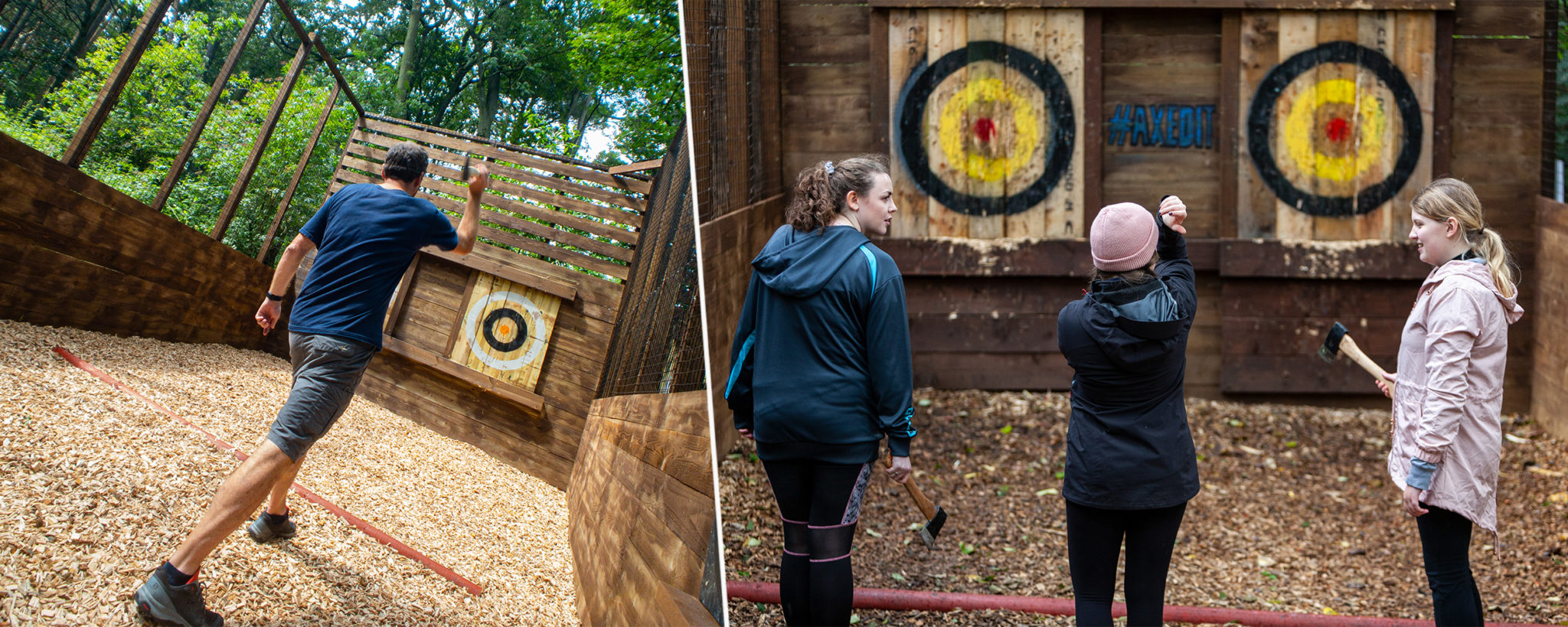Dive into the Axe Throwing Denver Scene: What You Need to Know
Dive into the Axe Throwing Denver Scene: What You Need to Know
Blog Article
The Fun of Axe Throwing: Just How This Sporting Activity Integrates Ability and Adrenaline for a Fun Time
Axe throwing has become a captivating sporting activity that masterfully intertwines the need for specific ability with the thrill of adrenaline, offering individuals a one-of-a-kind and interesting experience. The act of hurling an axe in the direction of a target demands concentration and method, concurrently fostering an atmosphere of sociability and friendly rivalry. This fascinating blend of mental emphasis and physical effort has made axe throwing a popular option for those seeking both recreation and a sense of success. To really appreciate the depth and allure of this activity, one should consider its beginnings, the needed devices, and the foundational methods that make sure both safety and security and satisfaction.
The Origins of Axe Throwing
Axe throwing, a leisure activity that has gained considerable popularity in recent years, traces its roots back to old times. The earliest documents of axe usage in competitive contexts are discovered amongst the Celts and Vikings, that tossed axes for sport as well as in battle training.
Medieval European warriors, particularly throughout the Middle Ages, exercised axe throwing as component of their martial training. The Francisca, a type of tossing axe used by the Franks, came to be renowned for its dangerous accuracy. This typical tool was made to be tossed at enemy guards and shield, showcasing its double utility in both sporting activity and battle.
In more current history, axe throwing saw a resurgence in the logging camps of North America in the 19th and 20th centuries. Lumberjacks would involve in pleasant competitors, examining their accuracy and stamina by aiming at wooden targets. This evolution from a survival ability to an entertainment activity has actually paved the method for its modern rebirth, with committed venues and leagues currently celebrating the sporting activity around the world.
Devices You Required
Understanding the rich background of axe tossing boosts the admiration of the sporting activity's modern-day model. For leisure and competitive axe throwing, the most commonly made use of kind is the hatchet, normally evaluating between 1.25 to 2 pounds with a handle length of around 16 inches.
Similarly vital is the target. Regulation targets are created from timber, with softwood varieties like pine or cottonwood being favored for their capability to take in and hold the axe. The target is generally split right into five concentric circles, each with a details factor value, to help with rating.
Safety and security equipment, however usually ignored, is important. Safety gloves can boost grip and protect against blisters, while closed-toed footwear are a must to secure feet from gone down axes (ax throwing denver). A well-lit, roomy tossing area, full with safety barriers, ensures a controlled atmosphere where individuals can focus on developing their abilities.
Basic Techniques Explained
Grasping the essential methods investigate this site of axe throwing is necessary for both security and proficiency. The first strategy to comprehend is the hold. Hold the axe with a firm, yet kicked back grip, similar to holding a golf club. The leading hand should be positioned directly listed below the axe head, while the non-dominant hand supports the end of the handle.
Your leading foot should be somewhat ahead, aligning with your target. This positioning help in maintaining stability and guiding power precisely in the direction of the target.

Safety And Security First
Ensuring safety in axe throwing is paramount to creating a delightful and injury-free experience. Safety gauges start with the venue layout. A properly designed axe throwing facility functions clear demarcations between tossing lanes, tough backgrounds to capture stray axes, and non-slip flooring to avoid crashes. In addition, appropriate lighting is vital to assist individuals preserve visual precision and spatial recognition.
Advantages of Axe Throwing
Axe throwing offers a myriad Homepage of benefits that extend beyond easy leisure. The repeated activity of tossing the axe likewise boosts hand-eye coordination and fine motor skills.
Emotionally, axe throwing requires precision, approach, and emphasis, making it a superb method to hone cognitive skills. The focus required to hit the target can work as a form of mindfulness, permitting individuals to remove their minds and lower tension. This psychological engagement can be especially beneficial in helping people establish far better problem-solving abilities and mental strength.
Socially, axe throwing is typically appreciated in team setups, promoting team-building and camaraderie. Whether as part of a business event or an informal trip with pals, the sport urges communication and cooperation. Additionally, the public experience of finding out and boosting together can enhance relationships and develop long lasting memories.
Final Thought

The earliest documents of axe usage in affordable contexts are discovered among the Celts and Vikings, who threw axes for sporting activity as well as in combat training. Release the axe when your hands are roughly at eye degree, allowing the axe's all-natural turning to assist it in the direction of the target.
A well-designed axe tossing center attributes clear separations between tossing lanes, strong backgrounds to capture roaming axes, and non-slip flooring to protect against accidents. Participants need to be advised on the appropriate means to take care of and toss the axe, highlighting regulated, intentional activities over strong throws.
In recap, axe throwing stands out as a sport that masterfully incorporates ability, precision, and adrenaline.
Report this page